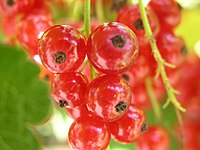
Photo from wikipedia
Composition and content of fatty acids were examined in total lipids of pericarpic tissues in the oriental wild apple (Malus orientalis Uglitzk.) grown in mountain regions of the North Caucasus.… Click to show full abstract
Composition and content of fatty acids were examined in total lipids of pericarpic tissues in the oriental wild apple (Malus orientalis Uglitzk.) grown in mountain regions of the North Caucasus. The fatty acids (FA) in pericarp outer layers (epidermis and hypodermis) and pericarp parenchymal parts were characterized by a comparatively low unsaturation index (UI): 0.902 and 1.115, respectively. This was caused by a relatively low content of polyunsaturated FA (34% in the outer pericarp parts and 45% in the pericarp parenchyma) with respect to the total FA content as well as by high level of saturated very-long-chain fatty acids (VLCFA) (15% in the pericarp outer parts). These values are in a marked contrast to those previously found for a similarly distributed cultural apple tree (Malus domestica Borkh.) that originated from M. orientalis as a parental species. The sum of diene- and triene-containing FA in M. domestica reached 59 and 76% in the pericarpic outer and parenchymal parts, respectively, and the sum of all VLCFA in the outer part of the pericarp did not exceed 1.7%. Such significant differences in fatty acid composition of lipids for related Malus species appeared during long-term selection of the domestic apple tree. On the one hand, M. orientalis, featuring a relatively low UI due to specific fatty acid composition of lipids, is less adapted to temperature stress and drought. In M. domestica, the cold and drought tolerance is corrected by artificial selection for this trait during breeding of cultivated varieties. On the other hand, the lipids of the oriental apple contain a high amount of VLCFA, which probably restricts the pericarp growth by regulating cell proliferation. At the same time, the abundance of VLCFA enhances plant resistance to fungal diseases, a property lost during the breeding of domestic apple.
Journal Title: Russian Journal of Plant Physiology
Year Published: 2020
Link to full text (if available)
Share on Social Media: Sign Up to like & get
recommendations!